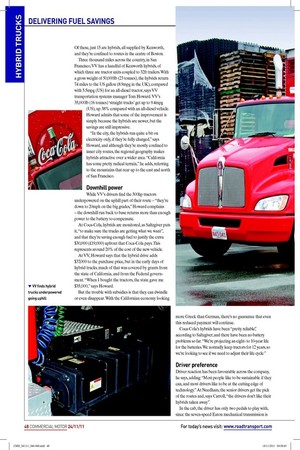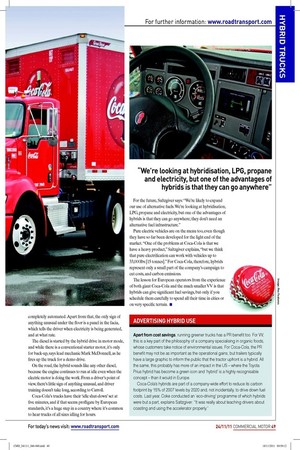DELIVERING FUEL SAVINGS
Page 38

Page 40

Page 41

If you've noticed an error in this article please click here to report it so we can fix it.
The US leads the way in hybrid vehicles In the past year, most European truck manufacturers have launched diesel-electric hybrid distribution trucks, but in the US they’re way ahead of the game. Just as hybrid cars have caught the imagination of American car owners in a way they haven’t in dieseldominated Europe, some US operators have embraced hybrids for their distribution leets.
And they’re getting astonishing results. Coca-Cola group director of leet for North America Steve Saltzgiver says: “In city driving, we can save 20%-30% or more in fuel compared with a regular truck.” In California, an organic vegetable distributor, Veritable Vegetables (VV), reports economy improvements of more than 30% with its hybrid trucks.
Yet in Coca-Cola’s massive line-up of 10,000 artics – in a total North American leet of 30,000 vehicles – about only 7% are hybrids, with no plans to increase that share signiicantly, says Saltzgiver, who’s based at the company’s HQ in Atlanta, Georgia. Given the savings he reports, why so few?
The answer lies in how they work. The Eaton hybrid driveline has an electric motor/ generator between the automated clutch and the transmission. The system recovers energy during braking, which is stored in a battery pack and then used either in tandem with the main diesel engine, to reduce its load and fuel consumption, or to run the truck for short distances on electric power alone. Most of Coke’s hybrids come from Freightliner and DAF’s sister irm Kenworth (KW), with a few from International. All have the Eaton driveline behind the engine – Eaton has more or less cornered the market for hybrid drives. In the KWs, the main power source is a 6.7-litre, 300hp Paccar PX-6 engine, a typical engine for a mid-weight truck. The hybrid drive sits unobtrusively between the engine and the transmission, and the most visible aspect is the hybrid battery pack – surprisingly small – on the side of the chassis. The system switches automatically from motor to generator as conditions dictate.
The hybrid drive, including the battery pack, adds about 132kg to the weight of a conventional truck, but that can be partly offset by having a smaller fuel tank.
Fuel saving
Below 30mph, power comes from a combination of diesel and electricity, but above 30, the drive is all diesel, and the hybrid auxiliary plays no part. That’s why, says Saltzgiver, the hybrid system has no advantages over a conven tional diesel in highway operation. “Duty cycle is a big factor in operating hybrids,” he explains. “The more stop and start, the better the fuel saving.” For this reason, Coke’s 700-odd hybrids are distributed among major cities where stop-start trafic is guaranteed, including New York, Washington DC, Baltimore and Boston, where Coke’s canning and distribution operation is based in the suburb of Needham.
The Needham site is a major city operation for Coca-Cola Refreshments, to give the company its proper name. The plant ships four million cases of soft drinks a month, says leet supervisor Mary Carroll, using 500 vehicles, ranging from 132 small delivery vans to 96 heavy-duty artics. Of these, just 15 are hybrids, all supplied by Kenworth, and they’re confned to routes in the centre of Boston.
Three thousand miles across the country, in San Francisco, VV has a handful of Kenworth hybrids, of which three are tractor units coupled to 32ft trailers. With a gross weight of 50,000lb (23 tonnes), the hybrids return 7.4 miles to the US gallon (8.9mpg in the UK), compared with 5.5mpg (US) for an all-diesel tractor, says VV transportation systems manager Tom Howard. VV’s 35,000lb (16 tonnes) ‘straight trucks’ get up to 9.4mpg (US), up 38% compared with an all-diesel vehicle.
Howard admits that some of the improvement is simply because the hybrids are newer, but the savings are still impressive.
“In the city, the hybrids run quite a bit on electricity only, if they’re fully charged,” says Howard, and although they’re mostly confned to inner city routes, the regional geography makes hybrids attractive over a wider area. “California has some pretty radical terrain,” he adds, referring to the mountains that rear up to the east and north of San Francisco.
Downhill power
While VV’s drivers fnd the 300hp tractors underpowered on the uphill part of their route – “they’re down to 20mph on the big grades,” Howard complains – the downhill run back to base returns more than enough power to the battery to compensate.
At Coca-Cola, hybrids are monitored, as Saltzgiver puts it, “to make sure the trucks are getting what we want” , and that they’re saving enough fuel to justify the extra $30,000 (£19,000) upfront that Coca-Cola pays. This represents around 20% of the cost of the new vehicle.
At VV, Howard says that the hybrid drive adds $37,000 to the purchase price, but in the early days of hybrid trucks, much of that was covered by grants from the state of California, and from the Federal government. “When I bought the tractors, the state gave me
▼ VV finds hybrid $35,000,” says Howard.
trucks underpowered But the trouble with subsidies is that they can dwindle going uphill or even disappear. With the Californian economy looking
more Greek than German, there’s no guarantee that even this reduced payment will continue.
Coca-Cola’s hybrids have been “pretty reliable”, according to Saltzgiver, and there have been no battery problems so far. “We’re projecting an eightto 10-year life for the batteries. We normally keep tractors for 12 years, so we’re looking to see if we need to adjust their life cycle.”
Driver preference
Driver reaction has been favourable across the company, he says, adding: “Most people like to be sustainable if they can, and most drivers like to be at the cutting edge of technology.” At Needham, the senior drivers get the pick of the routes and, says Carroll, “the drivers don’t like their hybrids taken away” .
In the cab, the driver has only two pedals to play with, since the seven-speed Eaton mechanical transmission is completely automated. Apart from that, the only sign of anything unusual under the loor is a panel in the facia, which tells the driver when electricity is being generated, and at what rate.
The diesel is started by the hybrid drive in motor mode, and while there is a conventional starter motor, it’s only for back-up, says lead mechanic Mark McDonnell, as he ires up the truck for a demo drive.
On the road, the hybrid sounds like any other diesel, because the engine continues to run at idle even when the electric motor is doing the work. From a driver’s point of view, there’s little sign of anything unusual, and driver training doesn’t take long, according to Carroll.
Coca-Cola’s trucks have their ‘idle shut-down’ set at ive minutes, and if that seems proligate by European standards, it’s a huge step in a country where it’s common to hear trucks of all sizes idling for hours. For the future, Saltzgiver says: “We’re likely to expand our use of alternative fuels. We’re looking at hybridisation, LPG, propane and electricity, but one of the advantages of hybrids is that they can go anywhere; they don’t need an alternative fuel infrastructure.” Pure electric vehicles are on the menu too, even though they have so far been developed for the light end of the market. “One of the problems at Coca-Cola is that we have a heavy product,” Saltzgiver explains, “but we think that pure electriication can work with vehicles up to 33,000lbs [15 tonnes].” For Coca-Cola, therefore, hybrids represent only a small part of the company’s campaign to cut costs, and carbon emissions.
The lesson for European operators from the experience of both giant Coca-Cola and the much smaller VV is that hybrids can give signiicant fuel savings, but only if you schedule them carefully to spend all their time in cities or on very speciic terrain. ■













































